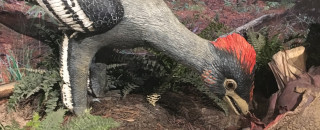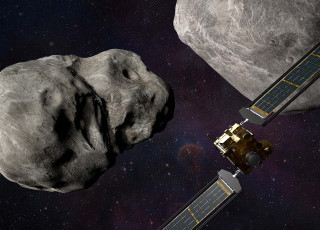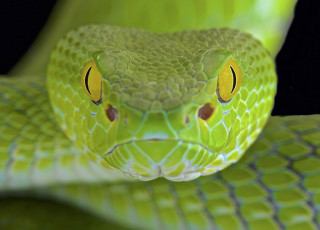The Top Science Stories of the Decade
The discovery of dinosaur color was one of the biggest finds of the decade. The colors of this raptor-like dinosaur at the NHMU is inspired by this new research. Credit: Riley Black
By Riley Black
Every day, we learn something new about nature. Scientists from all sorts of disciplines – from particle physics to paleontology – are making new discoveries, comparing novel finds to those made before, and raising new questions about the universe we live in. As we end this decade, here’s a look back at some of the most fascinating science stories of the past ten years.

1. Our First Look at a Black Hole
What does a black hole look like? Sci-fi flicks have offered plenty of dramatic speculations, but, the fact is, no one really knew. Scientists were able to detect the presence and influence of these enigmatic spots in space, but trying to visualize a place where no light can escape turns out to be a daunting task. But in April of 2019, after more than a decade’s worth of work, astronomers and computer scientists revealed our very first glimpse of the astronomical phenomenon.
2. The Zika Virus
Not all science stories are “wow” moments. Some can be frightening. Like the Zika virus that made headlines in 2015 and ’16. The mosquito-borne virus has been known since its discovery in 1947, but an outbreak in the Americas and suspected links to neurological problems in infants raised the disease’s profile during this decade. To date, researchers are still working on effective vaccines.
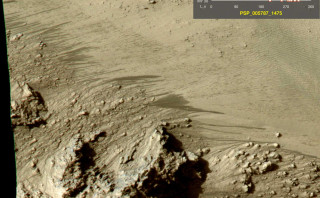
3. Go With the Flow
We may never know whether there’s life on Mars, as Ziggy Stardust put it, but it seems that there’s water. A 2015 study concluded that visual and chemical analyses of molecules found on the red planet indicate the presence of flowing water, which leaves streaks behind as the salt-laden fluid freezes and melts.
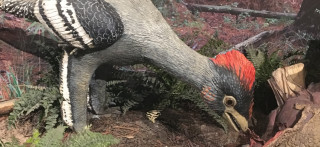
4. Dinosaur Colors
This discovery is big enough to make the jump from our dinosaur-exclusive list to this one, too. Tiny, pigment-carrying blobs in fossilized dinosaur feathers and skin are comparable to those found in living birds and other animals. By using some advanced imaging technology, paleontologists can detect these bodies in ancient organisms and reverse engineer at least some of the hues of long-dead dinosaurs. The method doesn’t work for every fossil – the pigment-carrying bodies have to be preserved in feathers, skin, or armor – but the breakthrough is huge in visualizing dinosaurs and envisioning their behavior.
5. Scientists Map Our Epigenome
You may remember that in 2003 researchers completed the Human Genome Project, providing the most comprehensive look at our species’ DNA. But what you might have missed is that the human epigenome is being mapped, too. These are the biochemical compounds that do things like switch certain genes on or off, or how a gene makes a protein. It’s a guide to how our genetics interacts with the outside world, and it represents a major breakthrough in understanding ourselves.
6. The Giant Squid, Revealed
We’ve known about giant squid for millennia. Seafaring tales, dead squid washed up on shore, and remains in whale stomachs assured scientists that the legends were real. But what about the living animal? The squid seemed to live so deep, and be so elusive, that generations of scientists were confounded in their efforts to spot the cephalopod. Then, in 2013, a team of scientists from Japan captured the first-ever footage of a live giant squid, revealing the animal in its natural habitat. Additional sightings have turned up since then, including one this year, but much of the squid’s biology remains a mystery.
7. Feeling the Heat
The connection between human activities and climate change has been clear for decades, but the crisis becomes ever-more important with each passing year. The past five years have been the hottest ever recorded, and the global climate is expected to become even warmer still – at least as much as 1.5 degrees centigrade. The effects of these changes are already being felt around the world, and the clock is ticking to curb the emissions that are driving the change.
8. The Gene-Editing Debate
Scientists have modified the genes of other species, but what about our own? In the past ten years, a genetic editing technique called CRISPR-Cas9 has been used to modify the genetics of various organisms and even raise the specter of changing modern animals to resemble prehistoric species – altering an elephant, for example, into something more like a mammoth. But this lab technique is now fueling fierce debate as it relates to humans. Editing the genomes of developing human embryos has raised major ethical questions and faced ardent condemnation as the availability of the technology has outstripped the regulatory guidelines for such interventions. As the next decade starts, the fight is just warming up.

9. A New Human
The past decade has seen multiple discoveries of ancient human relatives, but one of the most startling was Homo naledi. These people, found in South Africa’s Rising Star Cave, lived about 300,000 years ago. But they were not our ancestors. They were a different species of human, represented by over 1,500 bones belonging to at least 15 individuals. Why so many Homo naledi were buried in one place is unclear, but one idea is that the cave was a place of intentional repose – hinting that these people had a capacity for symbolic thought that was previously believed to be ours alone.
10. The Higgs Boson
No list of big scientific stories would be complete without the long-sought Higgs boson. This elusive particle has been the topic of scientific discussion since 1964, as it is thought to be important to the question of why particles have mass, but its existence was debated for decades. It wasn’t until 2012 that researchers at the European Organization for Nuclear Research were able to get experimental conditions just right to detect the Higgs boson in a huge piece of equipment called the Large Hadron Collider. Now that the Higgs boson has been spotted, its nature can come into focus.
Riley Black is the author of Skeleton Keys, My Beloved Brontosaurus, Prehistoric Predators, and a science writer for the Natural History Museum of Utah, a part of the University of Utah in Salt Lake City. Our mission is to illuminate the natural world and the place of humans within it. In addition to housing outstanding exhibits for the public, NHMU is a research museum. Learn more.
